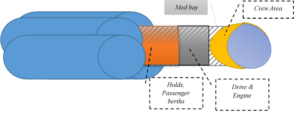For right now, the ship in episode 1 of the Salvage Project is called Brio’s Hope. Here’s a little backstory and detail on the ship from my notes.
Brio’s Hope is a solid workhouse of a space transport. It’s old but serviceable, and the crew are used to working in a pinch and using what’s at hand to fix problems.
Water onboard is used for drinking and, in limited fashion, for hygiene and cleaning the ship. Water is also used to preserve valuable seedlings and embryonic tanks for the colonists. It’s also used to generate oxygen and in CO2 removal systems. Solid waste is not reclaimed/reprocessed but stored for to be sold for composting later. The colonists worked out a deal for the compost to be used on-planet when they get there.
The Brio uses a water reclamation system that’s usually about 90% effective, but slow. Inefficiency in the system comes from the planned non-use by the crew of solid waste recycling, in oxygen generation, and from losses within the CO2 scrubbers. The colonists brought onboard a system that processes the solid waste into fertilizer, but the process doesn’t reclaim that much water.
So, the Brio has planned water stops along the long route, as well as secondary stops favored by the crew and noted in an open-source database used by most spacecraft (the elite luxury craft have proprietary systems) .
My rough diagram of the ship’s components is below. The bridge is a dome at the bow of the ship, and the crew area just behind the bridge bulges out like a squashed doughnut. The rest of the ship is cylindrical, the drive and engine compartment following the crew area, then the cargo holds. The water tanks surround struts with an enclosed cargo hold area in the stern of the ship.
